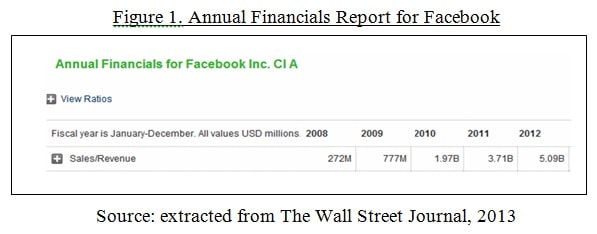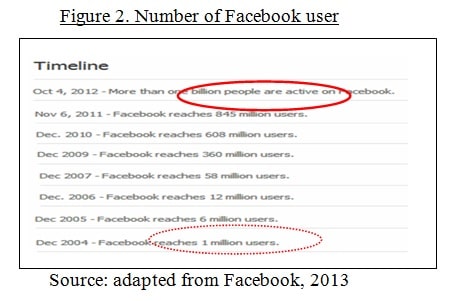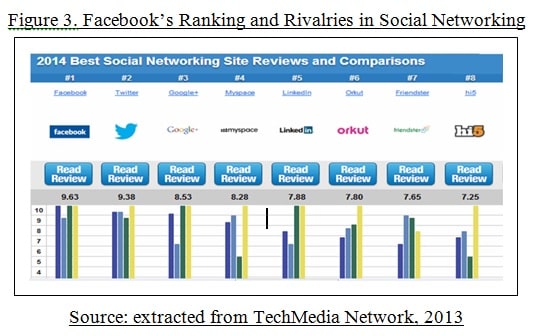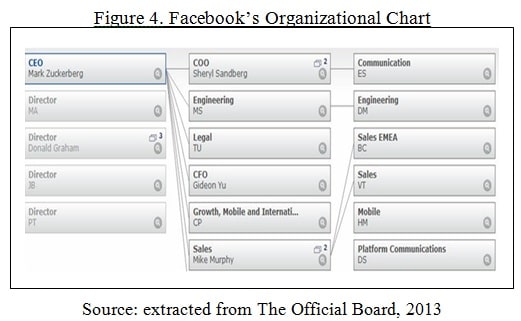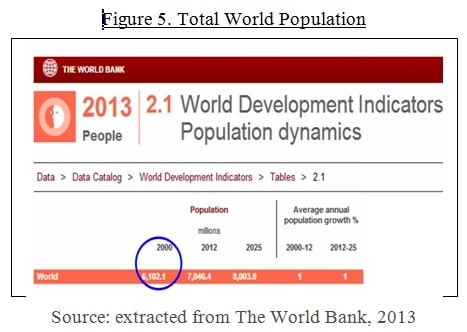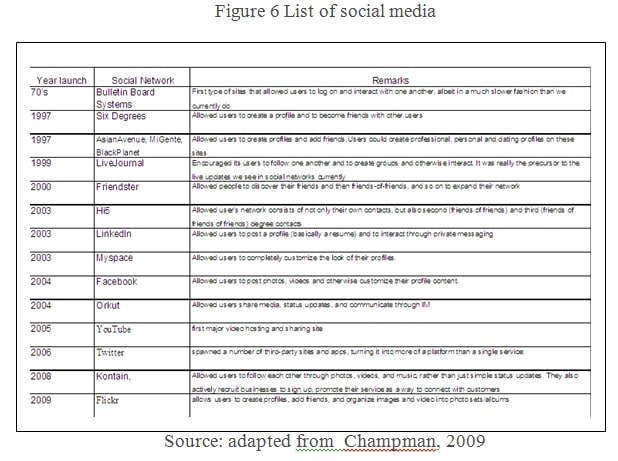MNG00114 Strategic Management Sample Assignment
Executive Summary
Facebook Inc. is the most successful social networking service provider in the world with a gigantic network of over 1 billion active users now. This humongous user base has created a powerful information database for Facebook which none of its competitors are close to having. The most intensified rivalry for Facebook is Google.
Google builds its core competency based on information management, having the most powerful search engine in the world now. Facebook differentiated themselves by focusing and emphasizing on human management, i.e. networking and connectivity of people. With this differentiation, Facebook had positioned itself differently from Google in the market. Coupled with the technological advantages, Facebook had taken good advantage of the advancement in mobile technology to enhance its reach to more social networking users.
In this report, the strategies pursued by Facebook during the early stage of their emergence were identified. These strategies were carefully crafted based on the external environment and conditions when they were getting into the market in 2004. The broad differentiation strategy deployed positioned the company well ahead from their competitors and the low-cost strategy enables their reach out to users of all ages and genders. These strategies had led the company to its successful position today.
The internal factors for Facebook were analysed based on their resources and capabilities. The most critical resources for Facebook are the large information database (tangible) and the human capital (intangible), i.e. their creative employees. It was discussed in this report that Facebook has to protect and grow the information database; and to retain their human capital at the same time, in order to continue its successful path ahead.
The final part of this report identified and analysed Facebook’s strength, weakness, opportunity and threats, to determine its current situation. It was recommended that Facebook pursue focused differentiation and focused low-cost strategies to target niche markets/users. The related key activities for Facebook surround their information database, cyber security and reduction of threats. Through these strategies and activities, Facebook can continue to enjoy success in the next decade.
1.0 Introduction
Facebook Inc. is an American company that offers online social networking services (Facebook, 2013). The access to Facebook is free of charge, and the company earns its money from advertisements on the web site (Kirkpatrick, 2010). New users can create profiles, upload photos, join a pre-existing group, and start new groups. The site enables users to alert friends to their current location or situation; and informs users of changes to their friends’ profiles and status (Walter, 2013). Users can signal their approval of content on Facebook with the Like button, a feature that also appears on many other Web sites (Kirkpatrick, 2010).
Eight years since its inauguration in 2004, Facebook now has the biggest base of active users in the social networking industry (Facebook, 2013). Their mission statement “Facebook’s mission is to give people the power to share and make the world more open and connected” (Facebook, 2013; Oleski, 2013; Bateman and Snell, 2011). Facebook success is attributed by the company’s strategies deployed. A company strategy is about competing differently from its competitors, and it consists of a distinctive element that attracts customers and produces a competitive advantage for the company (Thompson, Peteraf, Gamble, and Strickland III, 2012).
This report aims to evaluate Facebook strategies adopted since it was created; as well as its resources, capabilities and competitiveness, which put them in a leadership position within the social networking industry. The report also evaluates Facebook current strategic position and provides strategic options which will allow Facebook to remain a successful organization throughout the next decade.
2.0 Company Background
Facebook is the market leader in social networking sites which offers more than just an advertising service to its external customers. This idea was invented by Mark Elliot Zuckerberg and his classmates in year 2004 (Bellis, 2013; Gummerus, Liljander, Weman & Pihlstrom, 2013; Oleski, 2013; Haque, Momen, Sultana & Yasmin, 2013). Its headquarters is located in California. Under the team of management, the organization has been growing and remains strong in this competitive social media industries, with supported by 4619 total employees (Facebook, 2003; The Wall Street Journal, 2013; Bloomberg BusinessWeek, 2013; Pietro and Pantano, 2012). This statement can be supported with secondary research data base on the past 5years revenue record in Figure 1, where it shown a consistent growth nearly 2 billion per year since year 2010 and its active user has reach over 1billions monthly in year 2012 as compared to year 2004 only 1millions users (figure 2) (Facebook, 2013; The Wall Street Journal, 2013; Bloomberg BusinessWeek, 2013; Haque, Momen, Sultana & Yasmin, 2013).
In the subsequent section, Facebook’s external environment were evaluated using two known analytical tools, Porter’s Five Forces model and the PEST model. After which, the strategies deployed by Facebook were identified and discussed to determine how they aided Facebook in achieving their success in the social networking industry.
3.0 Strategic Analysis
According to studies by various authors’, strategic management refers to the capability of the management in managing the organisation to be able to adjust to the environment that they are competing. Therefore, in order to stay competitive, the management shall arrange their investment in more competitive ways that able to maximize the organisation profit, for example blue ocean strategy through innovation (Thompson et al, 2012; Olsen et. al., 2008; Abraham, 2012). This core concept is in-line with Facebook strategies, where they have successfully position themselves as an innovator and capture a large group of loyalty consumers (Walter, 2013). This can be seen clearly from their past 5year revenue performance in Figure 2.
3.1 Porter’s Five Forces Model of Competition
This is a key analytical tool is the most powerful and widely used tool for systematically diagnosing the competitive pressures in a market (Thompson et al, 2012). This model demonstrates that the competitive forces affecting industry profitability go beyond rivalry from competitors, and includes pressures stemming from four other co-existing sources, which include competitions from rival sellers, potential new entrants to the industry, and producers of substitute products; and bargaining powers of customers and suppliers (Thompson et al, 2012).
3.1.1 Industry Rivalry
The total world population in early 2000 is more than six billion people as shown in Figure 5 (The World Bank, 2013; Nation Master, 2013). This shows a large number of potential customers that can be drawn into social media. Due to this huge potential, there are many other social media players attracted to the market to have a slice of the pie. This is reflected from the beginning of the first “modern social network” like Six Degrees started in 1997, going into the 2000’s, Friendster came about as one of the modern and general social media site, created in 2002. LinkedIn was also founded in 2003, but focuses more on the professional scene whereby it allows users to network to exchange business and also in the same time, recruitment, which is slightly different from the rest of the social media service providers, listed in Figure 6 (Chapman, 2009). The rivalry is low at the beginning of Facebook emergence because of the huge market size and potentials (Kirkpatrick, 2010).
3.1.2 Threat of Substitutes
A substitute product is a different product that is supplied by another company in the market but can also meet the same customer needs that are met by another company’s product (Bensoussan & Fleisher, 2008). In perspective of Facebook, emails can be described as the ultimate substitute product. Nevertheless, the threat posed by emails is very low as Facebook offers more features while compared to what email provides (Walter, 2013).
3.1.3 Threat of New Entrants
With Facebook’s popularity on the rise, and low cost of initial investment and low barrier of entry in western country especially, this has attract more new entrants to share this slice of pie (Thompson et al, 2012; Anon, 2011). The threat of new entrants is moderately low as each social networking service provider are focused on niche market, unlike Facebook’s approach on general public users from all age and genders (Kirkpatrick, 2010). However, the eminent threat may come through merger and acquisition or strategic alliances within various social networking service providers (Walter, 2013)
3.1.4 Bargaining Power of Buyers and Suppliers
Facebook users are their most important suppliers and simultaneously, they are customers too. The users provide information, status updates, networks and activities that Facebook needed to use as a base to sell advertisement slots. It needs a base of users who are active enough (one billion active users per month on Facebook (Facebook, 2013) in its pages to gain page views in order promote and sell advertisement slots to their paying customers, in this case, the advertisers. The bargaining powers of Facebook users and advertisers are relatively low because of the humongous Facebook user base (Walter, 2013).
3.2 PEST Analysis
Further analysis of Facebook’s external environment can be substantiated by the use of PEST analytical tool. It is a framework of macro-environmental factors which can effectively determine the business conditions and climate, and is used widely in strategic management (Thompson et al, 2012).
3.2.1 Political
Operating in a worldwide environment, Facebook faces the biggest challenge on ensuring that the company is complying with every country’s privacy policy laws (Business Wire, 2013). Data protection is very important to Facebook’s operations as it uses user’s information to deliver advertisements.
3.2.2 Economic
Facebook is still a strong social media company with its annual revenue growing on a year-on-year basis from 2008 to 2012. However, there’s a big drop in net income in 2012 mainly driven by a higher expense in Research and Development, from US$388 million in 2011 to US$1.4 billion in 2012 (Facebook, 2013) in order to keep themselves competitive to keep the current users and attract new ones.
3.2.3 Sociocultural
Facebook tapped the very nature of human beings, which is the ability and the need to socialize. Any form and method of socializing would naturally attract the human being. Facebook offers new and exciting ways for the human being to interact with each other. Letting people know what they think and how they fell about a certain topic and allowing them to see what others have to say is already addictive enough to keep the users glued to Facebook.
3.2.4 Technological
Facebook started off as a web-based social media site, literally bounding its users to the desk and laptops only, limiting the time spent on Facebook. With technological advancements like the introduction of smartphones and high speed mobile Internet; Facebook is now capable to keep its users even more engaged in social media via the development of Facebook applications in smartphones (Abraham, 2012). People can check and update their Facebook even more frequently, thus being able to push more advertisements to them at the same time, an opportunity for Facebook to sell even more to its advertisers.
3.3 Facebook Strategies based on External Environment
Based on the challenges posted by the external environment, Facebook deployed a differential strategy where they positioned themselves well above their competitors, upon their entry to the social networking industry (Kirkpatrick, 2010). This was accomplished by having many different and new features for users to stay connected with the world and their acquaintances, as well as unique features to drive ease of use (Walter, 2013).
Facebook allows users to not only able to post pictures, but to also comment, like and tag other people (Chapman, 2009; Oleski, 2013; Pietro and Pantano, 2012, Facebook, 2013). These kinds of extra picture posting activities were previously not available on the older social Medias. It allowed the users to be more engaged with each other, thus creating a more additive environment for the users. Facebook needs to fend itself off from their friendly rivals, such as Friendfeed (launched in 2007), Flickr (launched 2004) and Twitter (launched 2006) (Chapman, 2009) by creating new features that is more advanced and user friendly to keep their current user based engaged and to attract new users example added new features like events creation and invitation to actual social events, bridging the gap between virtual connections with real actual events (Facebook, 2013). In the meantime, Facebook keeps its users happy by maintaining a social media site that is stable, safe and keeps itself current.
4.0 Facebook’s Resource Base View
A company’s resources and capabilities represent its competitive assets and are big determinants of its competitiveness and ability to succeed in the market place (Thompson et al, 2012). In this section, Facebook’s resources and capability were analyzed to determine the competitive assets which must be protected and strengthened in order to keep its competitive edge over their competitors (Miles and Muuka, 2011).
4.1 Tangible Resources
Facebook has more than 1 billion users worldwide (Facebook, 2013), and is the biggest user/customers information database as compared to Friendster, Linkedin, Google and other new entrants. This resources cannot be duplicated in other alternative social media due to the fact that facebook is the first mover which gives them the huge advantage. Facebook users are suppliers and customers at the same time and with the huge registered users/customers, it is very attractive for businesses looking to reach their target market within a short time.
4.2 Intangible Resources
Facebook has the resource base view strategy of developing and managing employee; they can enhance and attain competitive advantage through their employee (Miles and Muuka, 2011). VanDyne and LePine (1998) mention that productive suggestions from employee are needed for consistent improvement for the company:
4.2.1 Talent Hiring
Facebook expanded their resource base by hiring more talented employees; one of the important people would be Ms. Sheryl Sandberg from Google as Facebook’s chief operating officer who will oversee the oversea expansion and advertising developments (Stone & Helft, 2008). Subsequently, there are about 142 Google’s employee left to join Facebook (Miller, 2010). Facebook even acquire the whole team who start up ‘Spool’ that built some sophisticated technology and are expert in developing mobile software (Businessline, 2012).
4.2.2 Employees’ Approach
A platform had been built for all their employees to connect, share ideas and communicate with other colleagues. Employees are encourage having debates, trying out new products and have discussion on any problems or ideas. Facebook believe that these can help to create great products and also their employees learning from each other (Brusino, 2012). Having 5,299 employees worldwide, most of Facebook employees are youngsters in their twenties who are impatient. Hence, Facebook used ‘dogfooding’ to engage and retain its employees by creating gratification. This binds Facebook’s employees to the company and their products too, which let them feels responsible and invested in the company (Bhattacharya, 2013).
4.2.3 Employees’ Benefits
With Facebook growing rapidly, Mr. Zuckerberg shifted Facebook’s headquarter to a campus in Menlo Park, California. The new campus has many rooms for discussion or meetings, it has a cafeteria and snack stations that provide free food for all their employees, it even has free laundry service too and it is also able to house 9000 employees (Hartley, 2012). Facebook even engage a developer to build a ‘company town’ of 394 units of housing community that is with walking distance that cost $120 million for their employees. Facebook is hoping that with all the amenities it is able to take care of most of their employees lives and also to take away some of the stress from their work so that they can think more creatively (Albergotti, (2013). After the launching of the IPO for Facebook 2012, many of their employees had become millionaires. It was estimated that a total $23 billion were being share by about 3000 employees. With such a huge profit, these employees will have to pay a hefty sum of personal tax but they doesn’t have to worry due to Facebook will be paying $5 billion for their employee personal tax (Waters, 2012).
4.3 Facebook’s Critical Resources
The two most important resources which Facebook must continue to protect and strengthen are the information database attributed by the 1 billion active users and the human capital, i.e. their employees. Both resources are highly valuable, rare and hard to copy by their competitors (Kirkpatrick, 2010). They are also hard to substitute as the size of the information database is tremendously huge, compared to even the next closest competitor (Walter, 2013). In this situation, Facebook had to strategize to avoid losing users and/or to grow the user base, as well as to retain their creative employees for as long as possible, through the approaches described above (Waters, 2012).
5.0 SWOT Analysis
Internal and external environment affect business. Business uses SWOT analysis to evaluate its business, resources and environment. Strengths and weaknesses are positive and negative internal factors while opportunities and threats are external factors (Jiju, 2012). In the subsequent section, Facebook’s current situation is analyzed using SWOT analytical tool, which served as the basis for the recommended strategic options for Facebook to remain sustainably successful in the years ahead.
5.1 Strengths
Strengths usually represent the internal strong points of a business and these are things that companies do better than their competitors and are difficult to duplicate (Thompson, 2012). Facebook was set up initially as a medium to reconnect school friends who are no longer in contact once they left school (Kirkpatrick, 2010). Currently, Facebook has been the choice medium to share pictures and thoughts, Facebook is able to see a need and able to satisfy the need for its users. Facebook are technically competent that games are popularly liked by its users. The biggest strength of Facebook is the 1 billion active users in its information database, which is far ahead of the next closest competitor (Kirkpatrick, 2010).
5.2 Weaknesses
Weakness, an internal factor which does not meet the standard set by the company (Thompson, 2012). There are several weaknesses inherent in Facebook. Facebook users often face glitches and other programming bugs while using the application (Kirkpatrick, 2010). Security in Facebook are lacking that it is prone to hacking (Walter, 2013). Its term and policies are often violated for example by creating a fake account but it is not able to effectively enforce any infringement (Stone & Helft, 2008).
5.3 Opportunities
Opportunities may appear from market, competition and technology (Thompson, 2012). With technological advancement, the cost of connected to the internet is getting cheaper (Walter, 2013). Business presence is insignificant in Facebook where advertisement in Facebook could reach target market globally (Kirkpatrick, 2012). Facebook could be a very useful tool for business to collect user data through polls and surveys (Stone & Helft, 2008). Online retailing has been gaining in popularity too that Facebook could consider setting up a marketplace (Brusino, 2012).
5.4 Threats
Threats endanger a business and are external factors which may affect the profitability of Facebook (Thompson, 2012). As an online business, Facebook may be vulnerable to cyber-attacks (Stone & Helft, 2008). Breaches to its security system can cause personal data and files especially photos to be compromised (Bhattacharya, 2013). This can undermine the privacy of users. Facebook may also be affected by government regulations (Kirkpatrick, 2012). For example, Facebook could not create a presence in China where the potential is huge, due to the Chinese government regulations (Walter, 2013).
5.5 Strategies based on SWOT Analysis
According to Nadine and Anne (2009), the internal and external SWOT factors are used to developed strategies. Matching an internal factor to an external factor, strategies can be developed to enhance the business. In addition, a company’s competitive strategy deals with the specific management’s game plan for competing successfully (Thompson, 2012). The strategic options for Facebook to remain successful in the next decade are discussed in the following sections:
5.5.1 Information database
Facebook’s main strength is the large number of registered users (Kirkpatrick, 2010). Currently, not many businesses are using Facebook as a medium to reach out to its target market. With its strength in technology, Facebook should build a platform for business encouraging to them to use Facebook to reach out to their target audience. Facebook can deploy a focused low-cost strategy for the new platform to target and attract businesses (Thompson, 2012), where operating costs must be kept low for viable businesses and profitability (Walter, 2013).
5.5.2 Cyber Security
Facebook can either improve their cyber security team or work together with external parties, improving the security issues of their websites, Facebook can attract more users, especially businesses to register to their websites. Malicious cyber-attack on its servers, not only inconvenience users but such attacks may compromise their privacy. Instead of being vulnerable to cyber-attacks, Facebook could reward anyone who identifies any security loopholes in their system.
5.5.3 Reduction of Threats
Facebook could instill responsibility in the use of its platform by its users through the deployment of a broad differentiation strategy, targeting the mass of is user base (Thompson, 2012). There has to be an avenue to report an abuse, where users can report any incidence when an abuse takes place in Facebook. With a proper procedure to investigate any reported abuses, and taking appropriate actions against the abusers, Facebook could gain favorable standings with the global communities and even the Governments. This could pave the way for Facebook to make a presence in countries such as China.
6.0 Conclusion
The report provided an overview of the strategies pursued by Facebook since its inauguration in 2004. The broad differentiation and low-cost strategies deployed by Facebook were based on the external environment. These had successfully placed Facebook well ahead of their competitions in the social networking industry. This was evidently displayed by the over 1 billion active users within their information database at the end of 2012.
The critical resources of Facebook were identified to be the human capital of the company, i.e. employees, as well as the humongous information database supported by the 1 billion active users. Both resources are highly valuable and rare, hard to imitate and difficult to be substituted.
The current situation for Facebook was identified in the final part of the report. The protection and growth of their information database and retention of their creative employees are the main challenges for the company. Three key activities were discussed and it was recommended that Facebook deploys focused low-cost and focused differentiation strategies were obvious, in order to remain successful in the next decade.
Reference
Albergotti, R., (2013), Facebook’s Company Town; Social Network Is Building a 394-Unit Housing Community near Its Office, http://ezproxy.scu.edu.au/login?url=http://search.proquest.com.ezproxy.scu.edu.au/docview/1439126321?accountid=16926
Bateman, T., & Snell, S., (2011), Leading and Collaborating in a competitive world, 9th ed., New York: McGraw-Hill Irwin, pp.425-437.
Bellis, M., (2013), Who Invented Facebook,
Bensoussan E.B., & Fleisher, S.C., (2008), Analysis without paralysis: 10 tools to make better Strategic decisions, USA: Pearson Education Ltd.
Bhattacharya, S., (2013), Facebook using 'dogfooding' to retain and engage employees, http://ezproxy.scu.edu.au/login?url=http://search.proquest.com.ezproxy.scu.edu.au/docview/1448229572?accountid=16926
Bloomberg BusinessWeek, (2013), Company Overview of Facebook, Inc., available at http://investing.businessweek.com/research/stocks/private/snapshot.asp?privcapId=20765463 , viewed on 12th Nov 2013.
Brusino, J., (2012), The Long View: Stuart Carbb, http://ezproxy.scu.edu.au/login?url=http://search.proquest.com.ezproxy.scu.edu.au/docview/916924102?accountid=16926
Businessline, (2012), Facebook acquires Spool team, http://ezproxy.scu.edu.au/login?url=http://search.proquest.com.ezproxy.scu.edu.au/docview/1321633815?accountid=16926
Chapman, C., (2009), The History and Evolution of Social Media, available at http://www.webdesignerdepot.com/2009/10/the-history-and-evolution-of-social-media/, viewed on 16th November 2013.
Chris, J., (2013), Advantages & Disadvantages of a Vertical & Horizontal Organization, available at http://smallbusiness.chron.com/advantages-disadvantages-vertical-horizontal-organization-24212.html , viewed on 12th Nov 2013.
Chung, & Ronald, (1994), The horizontal organization: Breaking down functional silos, Business Credit, vol. 96 no. 5, p21.
Facebook Inc., (2013), Facebook Mission Statement, available at http://newsroom.fb.com/Key-Facts , viewed on 12th Nov 2013.
Figueiredo, J., & Oliveira. D., (2013), Structural dimension, in: The influence of the social capital on business performance: an analysis in the context of horizontal business networks The influence of the social capital on business performance: an analysis in the context of horizontal business networks. 14th ed. São Paulo: RAM, REV. ADM. MACKENZIE, V. 209-235
Gummerus, J., Liljander, V., Weman, E., and Pihlstrom, M., (2012), Customer engagement in a Facebook brand community, Management Research Review, vol. 35 no. 9, ProQuest pp857-877.
Haque, A., Momen, A., Sultana, S., and Yasmin, F., (2013), Online Brand Awareness: Determining the relative importance of Facebook and Other Strategies among the Malaysian Consumers, Information Management and Business Review, vol. 5 no. 4, ProQuest pp168-174.
Hartley, M., (2012), Facebook makes room for everyone; New campus to hold up to 9000 employees, http://ezproxy.scu.edu.au/login?url=http://search.proquest.com.ezproxy.scu.edu.au/docview/933515175?accountid=16926
Jiju Antony, 2012, "Reflective practice, A SWOT analysis on Six Sigma: some perspectives from leading academics and practitioners", International Journal of Productivity and Performance Management, vol. 61 no. 6, 2012, ProQuest pp. 691-698.
Kirkpatrick, D., (2010), The Facebook Effect: The Inside Story of the Company That Is Connecting the World, New York: Simon & Schuster.
Miles, S. J. and Muuka, G. N., (2011), Employee Choice of Voice: A New Workplace Dynamic, http://ezproxy.scu.edu.au/login?url=http://search.proquest.com.ezproxy.scu.edu.au/docview/880069429?accountid=16926
Miller, C. C., (2010), Google Grows and Works to Retain Nimble Minds, http://www.nytimes.com/2010/11/29/technology/29google.html?pagewanted=all&_r=0
Nation Master, (2013), People Statistics: Population (2003) by country, available at http://www.nationmaster.com/graph/peo_pop-people-population&date=2003 , viewed on 12th Nov 2013.
Oleski, C., (2013), Organisation Structure, Journal of Management, vol. 1 no. 1, ProQuest pp.2-5.
Olsen, M.D., West, J.J., & Tse, E.C.Y., (2008), Strategic Management in the Hospitality Industry, 3rd ed., Pearson Prentice-Hall, Upper Saddle River, NJ.
Pietro, L.D., & Pantano, E., (2012), An empirical investigation of social network influence on consumer purchasing decision: The case of Facebook, Journal of Direct, Data, and Digital Marketing Practice, vol. 14 no. 1, ProQuest pp.18-29.
Stalk, G.J., and Black, J.E., (1994), The myth of the horizontal organization, Canadian Business Review, vol. 21 no. 4, ProQuest p26.
Stone, B. and Helft, M., (2008), Facebook Hires Google Executives as No.2, http://www.nytimes.com/2008/03/04/technology/04cnd-facebook.html
TechMedia Network, (2013), 2014 Best Social Networking Site Reviews and Comparisons,
The official board, (2013), Facebook Organizational Chart, available at http://www.theofficialboard.com/org-chart/facebook , viewed on 12th Nov 2013.
The Wall Street Journal, (2013), Facebook Inc. Cl A, available at http://www.marketwatch.com/investing/stock/fb/charts?CountryCode=US , viewed on 12th Nov 2013
The World Bank, (2013), World Development Indicators: Population dynamics, available at http://wdi.worldbank.org/table/2.1, viewed on 12th Nov 2013.
Thompson, A.A., Peteraf, M.A., Gamble, J.E., & Strickland III, A.J., (2012), Crafting and Executing Strategy: Concepts and Cases, 18th ed., New York: McGraw-Hill Irwin.
VanDyne, L., and LePine, J.A., (1998), Helping and voice extra-role behaviors: Evidence of Construct and Predictive Validity, Academy of Management Journal, vol. 41, pp. 108-119.
Walter, E., (2013), Think Like Zuck: The Five Business Secrets of Facebook’s Improbably Brilliant CEO, New York: McGraw-Hill Irwin.
Waters, R., (2012), Facebook’s first employees to share $23bn, http://ezproxy.scu.edu.au/login?url=http://search.proquest.com.ezproxy.scu.edu.au/docview/921438980?accountid=16926
Appendix
